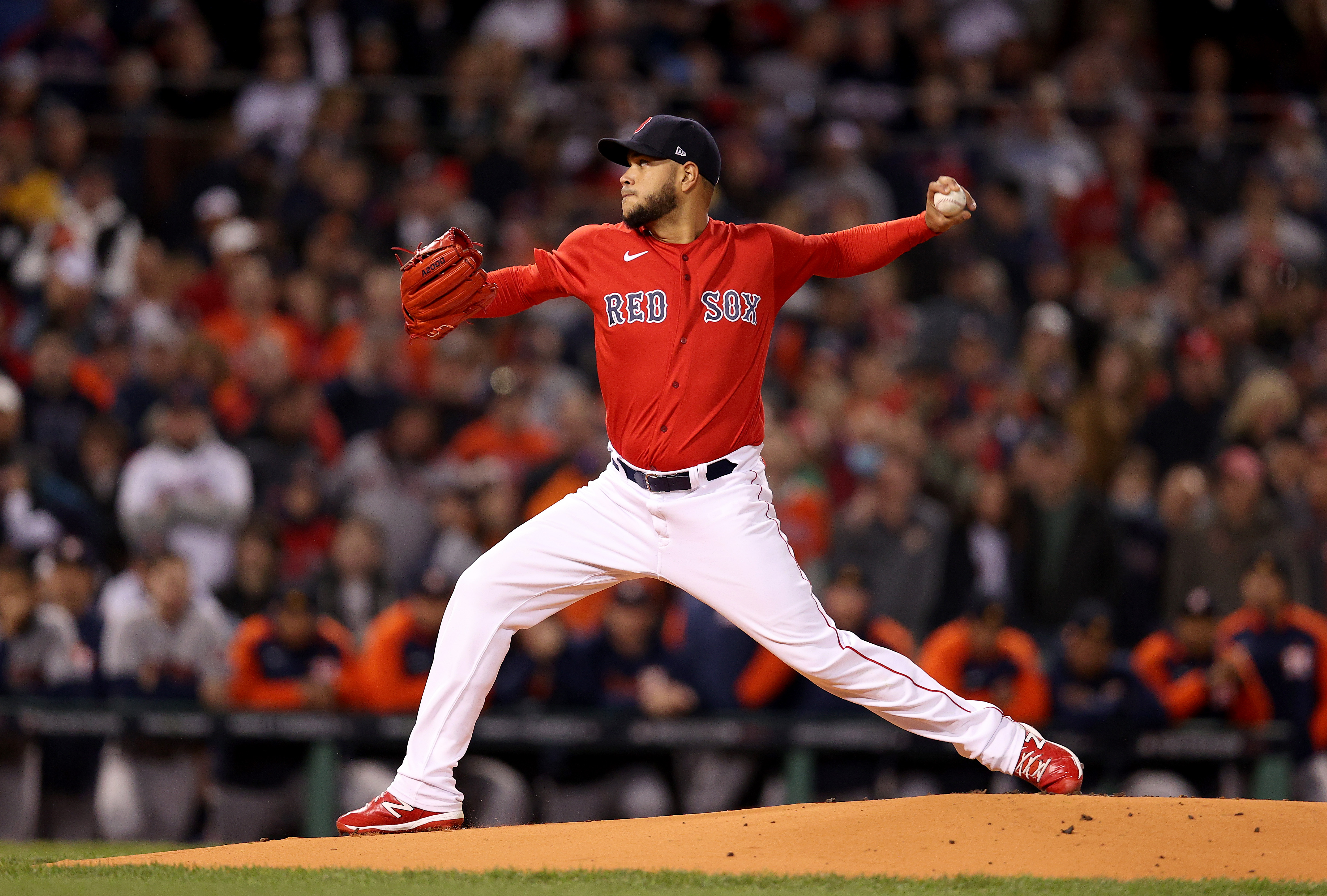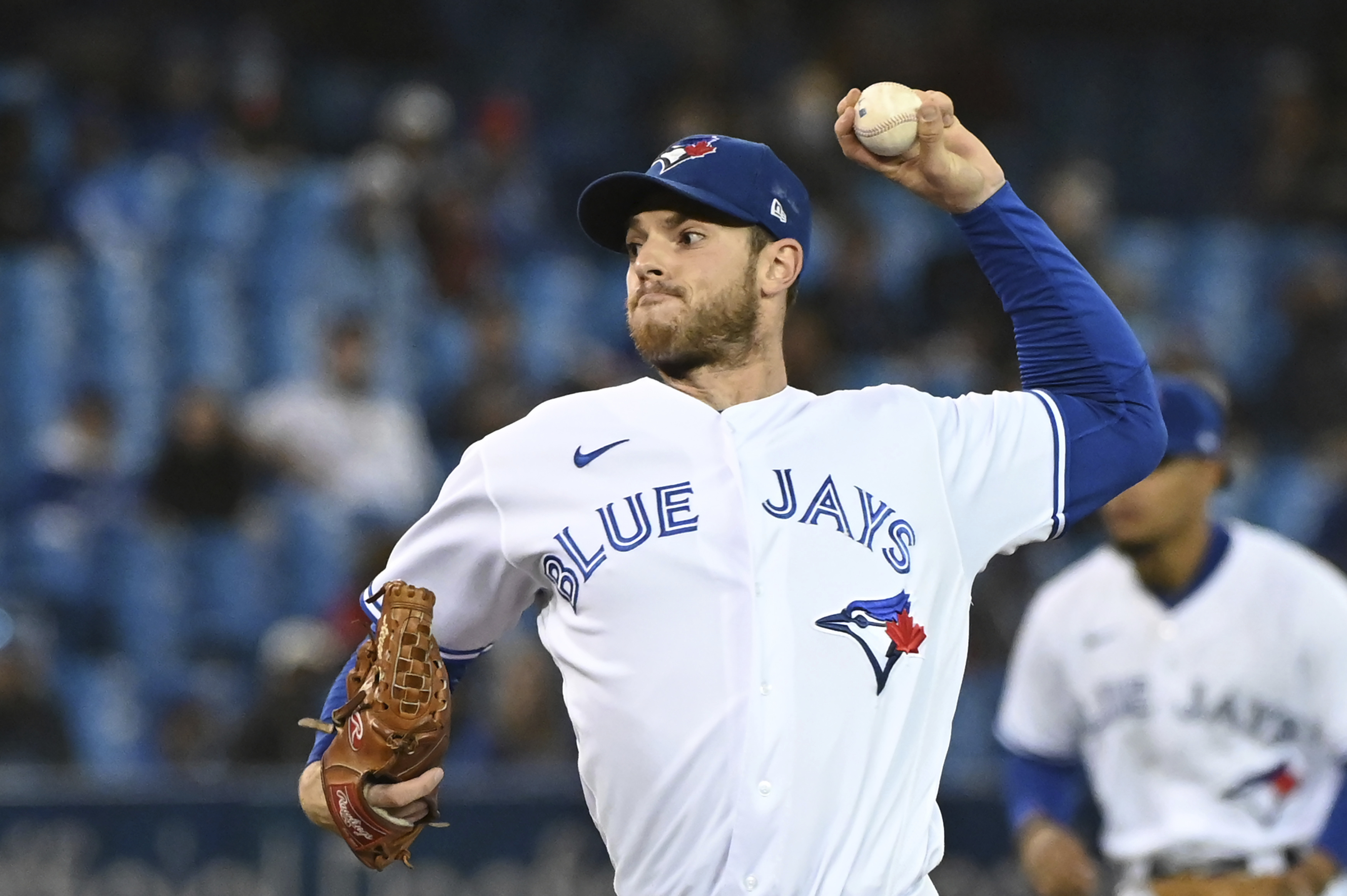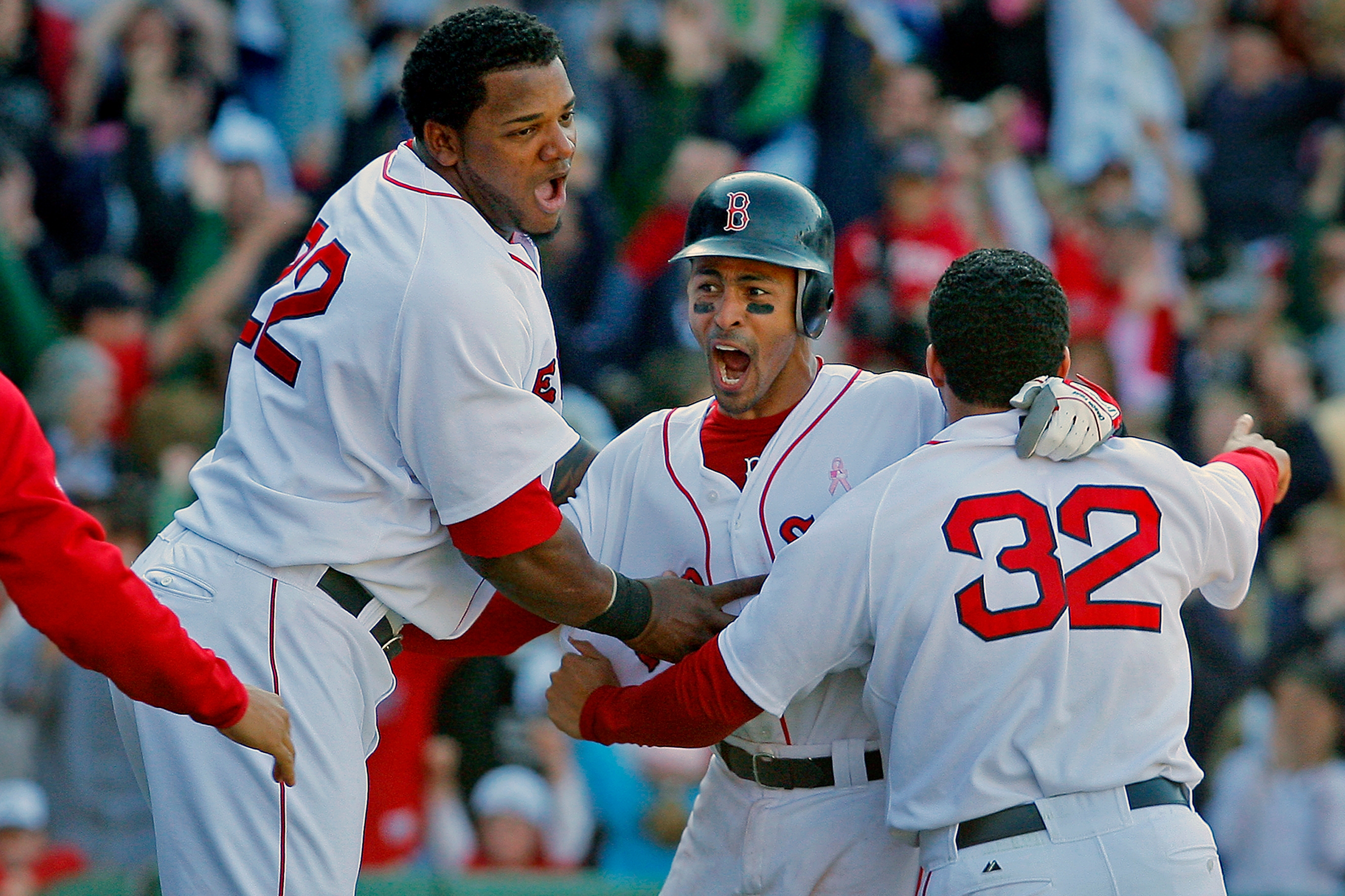
In an effort to tilt the playing field back a bit toward hitters, owners voted on June 3 to have umpires actively enforce the ban on foreign substances, with regular policing beginning June 21. The decision had a clear effect.
Spin rates declined, with a drop of roughly 50 revolutions per minute on four-seam fastballs between June 4-20 and another dip of about 40 RPMs with the official start of enforcement. Pitchers such as Garrett Richards made clear that the process of adapting was challenging.
Meanwhile, scoring rose, from 4.36 runs per game through June 3 to 4.62 runs per game thereafter. While scoring was influenced in part by the warmer weather and fatigue experienced by many pitchers as the season progressed, MLB believes the decision to enforce the ban on foreign substances by having umpires check pitchers’ gloves, hats, and belts achieved its intended effect.
“As we said in June, the prevalent use of foreign substances created an uneven playing field and contributed to a lack of action,” an MLB spokesperson wrote in an e-mail. “After the plans for enforcement became known, the league-wide offensive environment improved by virtually every measure. We believe that the increased enforcement of the existing rules was effective in leveling the playing field and deterring unfair competitive advantages.”
Yet deterrence may have waned. After the All-Star break, players, teams, and coaches often noted behaviors — pitchers wiping their hands on parts of their body that umpires weren’t inspecting, whether through their hair or their thigh or their ear — that raised suspicion.
Several Red Sox likewise expressed concern over Astros starter Framber Valdez repeatedly rubbing his temple before every pitch in Game 5 of the ALCS — an outing in which his stuff was significantly improved from his Game 1 performance.
Beyond such observations, there was also data. Spin rates crept back up in the second half of the season and jumped significantly for some pitchers who almost completely recovered the hundreds of RPMs they’d lost after enforcement began.
The average four-seam fastball in September was 93.8 miles per hour and 2,263 RPMs — almost identical to the 93.9 m.p.h. and 2,269 RPMs of an average four-seamer between June 4 and June 20, the pre-enforcement period during which some pitchers complied with the foreign-substances ban and others hadn’t.
So, did the league achieve its intended goal through enforcement?
“Initially,” said Cleveland Guardians president of baseball operations Chris Antonetti, who declined to elaborate.
Still, it’s possible that for some pitchers, the rebound in spin rates related to growing familiarity with the ball and mechanical adaptations that allowed them to generate spin and movement previously sought. It’s likely some pitchers resumed cheating once they saw a path to do so, but others seemed to figure out how to manipulate the ball with rosin and sweat.
“By and large, [enforcement] accomplished what it was intended to do and now the question is how do you sustain that level of enforcement over time,” said Mets president Sandy Alderson. “The risk is always that you put an emphasis on something and there is an emphasis on it initially, and then that emphasis wanes because of human nature.”
So, if MLB viewed the decision to enforce the ban as a success, how does it stop players from flouting the rules?
One possibility would be to change how inspections work. Multiple pitchers suggested umpires should feel pitchers’ hands rather than checking the same few pieces of equipment.
But MLB is also trying to offer pitchers a baseball that’s easier to grip. In the Arizona Fall League, balls have been rubbed with a non-mud substance that has received favorable reviews for its tackiness.
“There’s an initial chalkiness to it, but after that kind of gets wiped away and kind of rubbed down a little bit, I feel like there are a lot of good things about it,” said Red Sox minor league catcher Kole Cottam. “I definitely feel like it’s an improvement over the brand-new, original baseball. It’s a lot of steps in the right direction.”
“It was great. I liked it, but I’m not pitching with it; I don’t need any more surgery,” said Rangers general manager and longtime big league pitcher Chris Young. “I think it’s the right path forward.”
Commissioner Rob Manfred said Thursday that MLB is encouraged by the feedback it’s gotten. It’s possible MLB will be ready to test the balls in spring training, with a chance that they could be employed as soon as next year.
“Maybe it’s going to be 2023 instead, but we’re continuing to work on that project and it made real progress,” said Manfred. “The trick is, tackier but not so tacky that it’s Spider Tack. There’s a trick there.”
LEAVING A MARK
Rodriguez a big part of Sox’ success

The departure of Eduardo Rodriguez for the Tigers on a five-year, $77 million deal closed the book — at least for now (Rodriguez has an opt-out after two years) — on arguably the most successful Red Sox veteran-for-prospect trade of the century.
The deal sending Andrew Miller, then two months from free agency, to the Orioles in exchange for Rodriguez at the 2014 trade deadline represented the Sox’ biggest prospect acquisition since the trade of Heathcliff Slocumb to the Mariners for Jason Varitek and Derek Lowe in 1997.
Though overshadowed in the Sox rotation for most of his career, Rodriguez, who was in Double A when the Sox acquired him, made 153 starts for Boston, 29th in team history and seventh among lefties. He ranked just behind Bill Lee, Jim Lonborg, Dutch Leonard, Rick Porcello, Smoky Joe Wood, and Earl Wilson, and just ahead of Babe Ruth, Oil Can Boyd, and Red Ruffing in starts. Rodriguez was an above-average starter, posting a 4.16 ERA over a span in which the American League as a whole had a 4.30 mark — a performance made more impressive by his pitching in the AL East. He was a solid mid-rotation presence on a team that won a title and reached the playoffs four times.
“It’s not always easy to break into this market as a starting pitcher. He was able to do it as seamlessly as few have,” said Red Sox assistant GM Eddie Romero. “Our overall record with him on the mound [98-55] reflects that. He was just a rock in our rotation. His performance in a lot of pressure games was key for us.”
The 28-year-old loved pitching in Boston, and by several accounts would have been delighted to remain. But the Tigers proved more aggressive in courting the lefty, and the Sox — who extended a qualifying offer (one-year, $18.4 million) and pursued a multiyear deal — weren’t prepared to match Detroit’s five-year bid. Rodriguez will be introduced by the Tigers on Monday.
Some other observations on the Red Sox:
▪ Rodriguez wasn’t the only pitcher who received a contract offer from the Sox in the earliest days of the offseason. The team joined a peloton of teams bidding on lefthander Andrew Heaney (8-9, 5.83 ERA, 129⅔ innings with the Angels and Yankees in 2021), whose struggles were little deterrent to teams drawn to his swing-and-miss stuff (26.9 percent strikeout rate compared with an MLB average of 23.2 percent) and strike throwing (7.3 percent walk rate, below the league average of 8.7 percent). Such numbers suggested a potential to emerge as the next Robbie Ray — the lefthander who signed a one-year, $8 million deal with the Jays last winter then sharpened his command and emerged as a Cy Young winner. Initially, the Sox followed a familiar formula in their pursuit of Heaney, seeking a one-year deal that included a team option — a structure that has characterized most of the free agent signings since Chaim Bloom arrived as chief baseball officer in October 2019. But in a sign of the team’s investment in 2022, the Sox proved willing to make a straight one-year offer to Heaney, one that was competitive with the $8.5 million he signed for with the Dodgers.
▪ While the Sox were interested in Heaney on a one-year contract, the same was not true of another prominent free agent who sought a one-year deal in hopes of reestablishing his value before hitting the market again next winter. According to major league sources, the Sox were not interested in righthander Noah Syndergaard given that, as a recipient of a qualifying offer from the Mets, he would require not just a sizable salary but the sacrifice of a second-round draft pick and $500,000 in international bonus pool money. Syndergaard signed with the Angels for $21 million. The Red Sox had greater interest in Justin Verlander but talks never advanced before the righthander re-signed with the Astros on a one-year, $25 million deal that includes a $25 million player option for 2023.

▪ The Sox are trying to shore up the rotation with Rodriguez gone. They have had varying degrees of contact with virtually all of the top starters on the market, including Ray. One pitcher prominently on the radar: lefthander Steven Matz. The 30-year-old went 14-7 with a 3.82 ERA, 22.3 percent strikeout rate, and 6.6 percent walk rate for the Blue Jays in 2021 — impressive given Toronto’s nomadic journey through environments hostile to pitchers. Matz, who did not receive the qualifying offer and won’t require the sacrifice of a draft pick, has many suitors. He’s hoping to choose a team before Thanksgiving so he can finalize a contract before an anticipated lockout on Dec. 2.
▪ Matz already played a role in shaping the 2022 Red Sox. The Mets sent him to the Jays last winter for a three-player package that included righthander Josh Winckowski. The Mets then flipped Winckowski to the Sox in the three-team Andrew Benintendi deal, with outfielder Khalil Lee going from the Royals to the Mets. Winckowski, who will be added to the 40-man roster Friday, looms as one of the best Sox pitching prospects after going 9-4 with a 3.94 ERA, 21.3 percent strikeout rate, and 6.9 percent walk rate in Double A and Triple A. He doesn’t get a lot of swings and misses, but he attacks the strike zone with solid command and a balanced mix anchored by a fastball that topped out at 99 m.p.h. in the Arizona Fall League. “Extremely talented individual. He’s got really good stuff,” said Sox minor league pitching coordinator Chris Mears. “For me, there’s definitely a starter’s repertoire there.”
▪ The Sox are looking to upgrade their bullpen but likely won’t limit their search to familiar names. It’s worth recalling that last year the Sox filled out their bullpen with a trade (Adam Ottavino), international free agent signing (Hirokazu Sawamura), and Rule 5 selection (Garrett Whitlock). While the Sox will be active in the traditional free agent reliever pool, they’re expected to look internationally for help.
▪ Outfielder Seiya Suzuki, a star for the Hiroshima Carp in Japan, is expected to be posted for bidding as soon as this coming week, opening the door for the 27-year-old to negotiate with big league teams. Virtually every team, including the Red Sox, is expected to try to engage with Suzuki, who in 2021 led Nippon Professional Baseball in average (.319), OBP (.436), and slugging (.644) while smashing 38 homers.
One evaluator who covers Asia described Suzuki as profiling in the big leagues as a solid everyday right fielder, someone whose setup as a hitter (he holds his hands away from his body and has a leg lift) could create a transitional challenge to higher velocity. That evaluator saw him as someone with serious power and very good defense but who may hit for modest averages, a profile that sounds in some ways comparable to Sox right fielder Hunter Renfroe.
ETC.
A home run for minor leaguers
In a landmark development, MLB announced Thursday that it would start providing in-season housing for minor league players. At a time when the financial, physical, and mental stress on minor leaguers scrambling for affordable housing had become acute (thanks to rent increases borne by the pandemic) and well documented, the owners committed to the provision of furnished housing within a reasonable commute of the ballpark to any players not on a major league contract or making a minor league salary of $100,000 or more.
Players are guaranteed their own bed, with no more than two players to a bedroom. The days of having a handful of air mattresses crammed into every nook of a leased apartment are over.
“Housing has been a tremendous burden on minor league players for a very long time,” said Harry Marino, executive director of Advocates for Minor Leaguers. “The standard setup of six guys in a two-bedroom apartment all sleeping on air mattresses with no other furniture is unfortunately very well known to all minor league players. Fortunately, going forward, it will be a thing of the past.”
That said, the housing provision isn’t an end point for improving the living conditions of minor leaguers. While MLB increased the minimum salaries of minor leaguers in 2021 to roughly $400 to $700 per week (depending on the level), that salary is only guaranteed during the season — not the offseason (when players are required to train) or spring training. The minimum full-season salary is between $4,800 and $8,000 per year.
“That setup, much like the housing setup that we just saw fall, is a relic from a bygone era,” said Marino. “These players deserve a livable annual salary for the year-round work that they’re doing. That will be our next area of focus.”

Former Red Sox shortstop Julio Lugo died one day before his 46th birthday. He arrived in the 2006-07 offseason for a team looking for championship contributors. Lugo’s performance largely fell short of expectations — save for the 2007 World Series sweep of the Rockies, when he was dynamic offensively and defensively. Despite immense scrutiny that came with being a high-profile free agent, his joy (several members of the team recalled his smile above all else) in being around the game and his teammates remained undiminished — not just during his career, but any time he returned to Fenway after it. Rest in peace … Happy 46th birthday to J.D. Drew, who arguably represented the best big-money free agent signing by the current Red Sox ownership group until the acquisition of J.D. Martinez in 2018. And happy 37th to Quintin Berry, who was 3 for 3 in stolen base attempts in the 2013 postseason en route to a ring.
Michael Silverman of the Globe staff contributed to this report.
Alex Speier can be reached at alex.speier@globe.com. Follow him on Twitter at @alexspeier.
